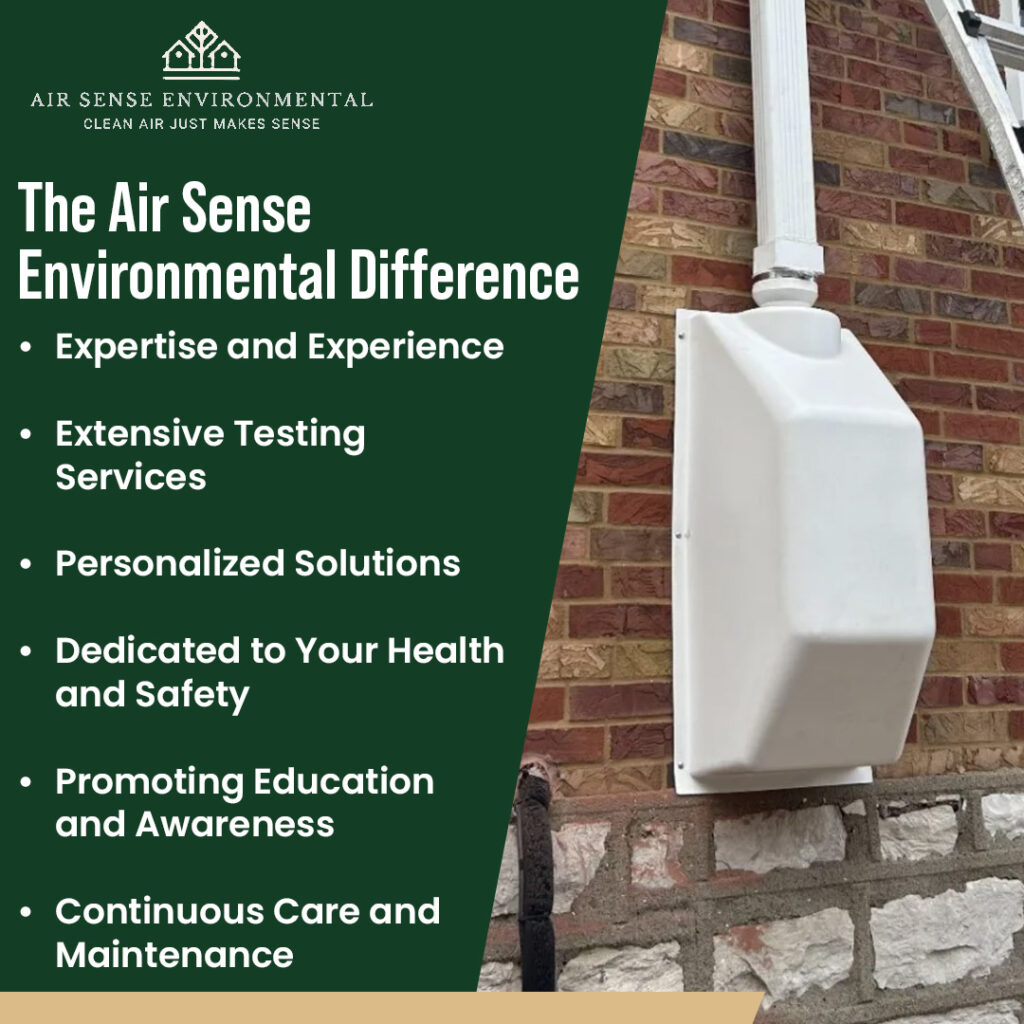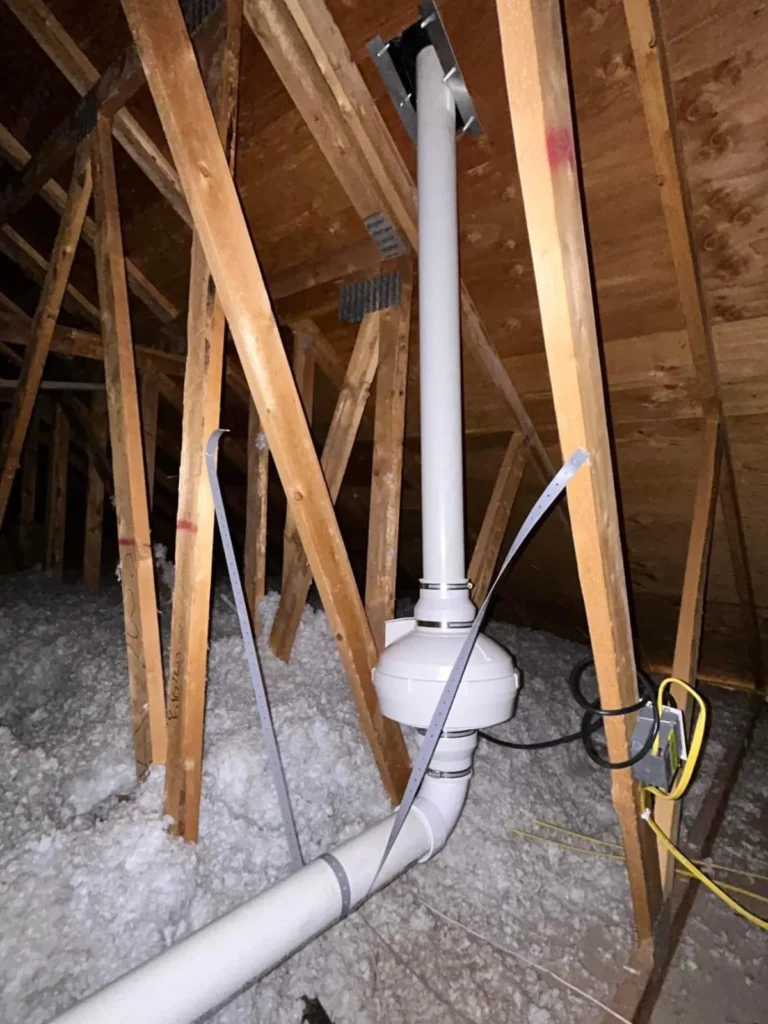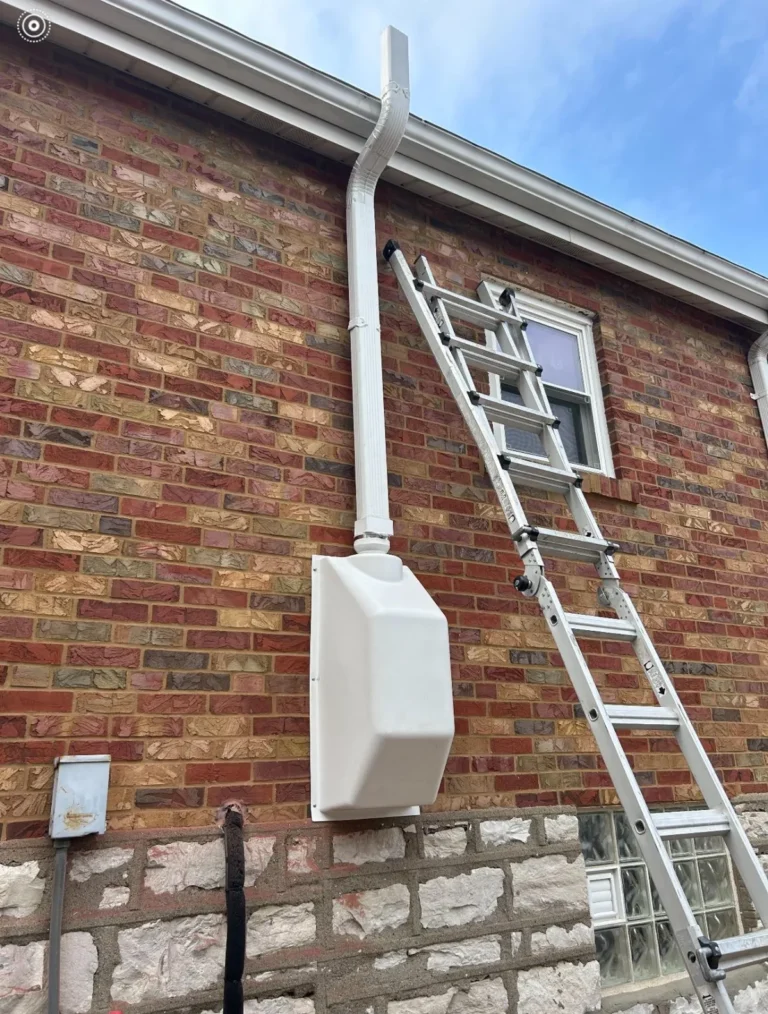In many homes, indoor air quality (IAQ) is an important factor that is frequently overlooked. The fact that interior air quality might be worse than outside air quality may not be known to the people of Edwardsville, Illinois, and the surrounding St. Louis area. This frequently results in serious health issues, particularly for vulnerable populations like children, the elderly, and people with underlying medical disorders. Poor IAQ can cause long-term health effects, including heart difficulties and respiratory ailments, as well as immediate issues like headaches and fatigue.
Air Sense Environmental intends to increase awareness of the dangers of poor IAQ and the steps needed to improve it. Our goal is to educate homeowners on how to take charge of their interior spaces by providing thorough air quality testing and customized solutions. Maintaining a safe and healthy home requires knowing the causes of poor IAQ and the possible health hazards connected to it. We are here to help you and those you care about live in a cleaner, safer environment, which will ultimately enhance your quality of life.

What Is Indoor Air Quality?
The state of the air inside buildings is referred to as indoor air quality (IAQ), and it includes a variety of elements that affect comfort and health. The presence of different pollutants, humidity levels, and the efficiency of ventilation systems all affect indoor air quality (IAQ). Since most people spend a large amount of time indoors, maintaining a high standard of indoor air quality is important for residents’ health.
Dust mites, pet dander, mold spores, volatile organic compounds (VOCs), and radon are a few examples of common indoor air contaminants. Dust mites and cat dander can trigger allergic reactions and asthma symptoms, while mold spores can cause respiratory issues since they thrive in damp settings. IAQ is an issue for many homes because volatile organic compounds (VOCs), which are present in paints, cleaners, and air fresheners, can release dangerous chemicals into the atmosphere. Another dangerous contaminant that can build up in homes and is connected to lung cancer is radon, a naturally occurring radioactive gas.
One important component of indoor air quality is humidity levels. Low humidity can lead to discomfort and dry respiratory symptoms, whereas high humidity creates an environment where mold and dust mites can thrive. Controlling humidity and pollution requires adequate ventilation. Good ventilation systems contribute to better indoor air quality by bringing in fresh air and lowering the concentration of indoor pollutants.
Homeowners must regularly check their interior air quality due to the numerous sources of indoor air pollution and the possible health effects they may have. Regular air quality testing can help identify specific contaminants and guide effective improvement efforts, allowing you and your family to live in a healthier environment.
Why Does Indoor Air Quality Matter?
Indoor air quality (IAQ) is significant for several important reasons, primarily due to its impact on health and overall well-being. The average person spends about 90% of their time indoors, which makes the quality of the air we breathe in our homes a vital consideration.
- Health Concerns from Poor IAQ: Poor indoor air quality can cause immediate symptoms such as headaches, fatigue, and respiratory problems. Both daily living and general well-being may be impacted by these symptoms. Chronic exposure to poor IAQ can lead to more severe health issues, including respiratory diseases, cardiovascular diseases, and even some forms of cancer. (WHO)
- Impact on Vulnerable Populations: Certain populations—such as children, the elderly, and individuals with pre-existing health conditions—are particularly sensitive to indoor air pollution. Children breathe more air relative to their size, and their developing respiratory systems make them more vulnerable to the effects of pollutants. Elderly individuals and those with existing conditions may experience more severe reactions to poor IAQ.
- Quality of Life: Poor IAQ can reduce overall comfort levels in your home. Discomfort may result from symptoms like eye, nose, and throat irritation. Additionally, studies show that low indoor air quality may lead to reduced cognitive function and productivity, affecting work or study performance.
- Economic Implications: The economic burden of health issues tied to poor IAQ can be significant. Healthcare costs related to conditions like asthma and other respiratory diseases tend to increase in households with known air quality problems. Additionally, homes with poor IAQ may see diminished market value, as prospective buyers are often wary of potential health risks.
The Hidden Dangers of Poor Indoor Air Quality
Indoor air quality (IAQ) is an often-overlooked aspect of our living environments, yet it can have profound implications on health and well-being. Below are several hidden dangers associated with poor indoor air quality, along with supporting statistics and recommendations to improve the situation.
1. Respiratory Issues
Poor indoor air quality is strongly linked to respiratory problems. High concentrations of pollutants such as pet dander, dust mites, and mold spores can aggravate asthma and other chronic respiratory diseases. According to the studies, nearly 26 million Americans have asthma, with a significant portion of these cases triggered by poor IAQ.
For instance, a study published in the AJRCCM found that children who live in households with elevated levels of indoor allergens are far more likely to develop asthma. Particulate matter is a common indoor contaminant that can irritate and inflame the lungs by penetrating deeply. By using air quality testing, you may find dangerous contaminants in your house, so take the appropriate action to safeguard your respiratory health and enhance the quality of the air.
2. Allergies and Sensitivities
Various indoor air pollutants—such as dust, mold, and chemicals commonly found in cleaning products—can trigger allergic reactions. These pollutants may cause inflammation and irritation, leading to symptoms like sneezing, nasal congestion, skin rashes, and even breathing difficulties.
Exposure to indoor allergens can exacerbate pre-existing symptoms or cause new sensitivity, and the number of people with allergies is still rising. Managing indoor air quality plays a key role in reducing these effects. If you or your family members often experience allergy symptoms at home, air quality testing can help identify specific triggers. This allows you to take meaningful steps toward creating a healthier indoor environment.
3. Mental Health Concerns
The quality of air you breathe can also affect your mental well-being. Studies indicate that poor IAQ can contribute to anxiety and depression. People at workplaces with improved air quality reported higher levels of mental clarity and cognitive performance, according to a study by the HSPS.
High carbon dioxide levels, which are frequently caused by poor ventilation, can affect your mood and cognitive abilities by making you feel exhausted and low on energy. The WHO has noted a correlation between IAQ and mental health, stating that improving air quality can lead to greater well-being and productivity. Consider implementing mechanical ventilation or investing in air purification systems to improve air quality and positively influence your mental health.
4. Long-Term Health Risks
Prolonged exposure to low-quality indoor air might cause major health problems. Chronic respiratory problems, cardiovascular diseases, and even lung cancer have been associated with poor air quality.
According to the WHO, indoor air pollution can cause long-term illnesses like chronic obstructive pulmonary disease (COPD) and respiratory infections, among other major health problems. Air quality testing is vital for identifying these risks. Regular testing allows homeowners to take proactive measures that minimize long-term health complications associated with contaminated indoor air.
5. Impact on Children and Vulnerable Populations
Children and other vulnerable groups may be particularly harmed by poor indoor air quality. Children are more sensitive to airborne pollutants due to their smaller size and still-developing lungs, making them more likely to be affected by allergens, smoke, and other irritants. When exposed to contaminated indoor air, older persons and people with underlying medical issues may also react more strongly.
Improving indoor air quality helps create a healthier home environment for everyone, particularly for those more at risk. Using air filtration systems, managing humidity levels, and keeping the home clean can go a long way in reducing exposure to harmful pollutants and supporting better respiratory health.
Factors Contributing to Poor Indoor Air Quality
Now that we’ve outlined the dangers, it’s essential to understand what contributes to poor indoor air quality. Here are a few common factors:
- Inadequate Ventilation: Homes that are tightly sealed to conserve energy may trap pollutants inside, leading to unhealthy air quality. Proper ventilation helps dilute contaminants and bring in fresh air.
- Moisture and Humidity: Excess moisture can create a breeding ground for mold and mildew, which can severely affect air quality. High humidity levels also help dust mites thrive, leading to more respiratory issues.
- Household Products: Many household items, including cleaners, paints, and pesticides, contain volatile organic compounds (VOCs) that can contribute to poor air quality. Using these products in poorly ventilated spaces increases pollutant concentration.
- Dirty HVAC Systems: A poorly maintained heating, ventilation, and air conditioning (HVAC) system can circulate dust, allergens, and other contaminants. Regular maintenance and cleaning of these systems help maintain good indoor air quality.
How to Improve Indoor Air Quality
Improving indoor air quality is vital for health and well-being. Here are actionable steps you can take:
1. Conduct Air Quality Testing
The main step in addressing poor indoor air quality is to conduct air quality testing. This process helps identify pollutants, allergens, and VOCs present in your home. At Air Sense Environmental, we offer reliable air quality testing in St. Louis to assess your indoor conditions.
By understanding your home’s air quality, you can take informed actions to improve it.
2. Enhance Ventilation
Improving ventilation in your home is key to promoting fresh air circulation. Open windows when weather permits, use exhaust fans in kitchens and bathrooms and consider installing mechanical ventilation systems that provide a consistent flow of outdoor air.
3. Control Humidity Levels
Keep humidity levels in check to prevent mold growth. Dehumidifiers can help maintain ideal humidity levels (between 30% and 50%). Regularly check for leaks and water damage, which can increase moisture levels.
4. Use Air Purifiers
Air purifiers equipped with HEPA filters can help remove airborne particles, including dust, allergens, and pollutants. Investing in a quality air purification system can substantially boost the quality of air in your home.
5. Regular HVAC Maintenance
Make sure that your HVAC systems are regularly maintained and cleaned. Change filters regularly and schedule professional inspections to prevent the buildup of pollutants, ensuring efficient operation.
6. Choose Low-VOC Products
Opt for household products labeled as low-VOC. Avoid using chemical-laden paints, cleaners, and air fresheners that can contribute to indoor pollution.
7. Eliminate Sources of Indoor Pollution
Identify and address sources of indoor pollution. This may involve removing moldy materials, sealing cracks that allow pests to enter, and reducing the use of scented candles or incense.
The Importance of Professional Help
While some steps can be taken independently, consulting with professionals like Air Sense Environmental is vital for a thorough evaluation. Our team understands how to assess indoor air quality effectively and provides solutions tailored to your specific needs.
Regular air quality assessments can help you stay proactive in maintaining a healthy indoor environment. If you live in the Edwardsville area or nearby St. Louis, we are here to assist you with extensive air quality testing and mitigation solutions.
The Air Sense Environmental Advantage
At Air Sense Environmental- Radon Mitigation & Testing, our commitment to improving indoor air quality goes beyond simply offering services; we aim to create healthier living environments for families in Edwardsville, IL, and the surrounding St. Louis area. Here’s what sets us apart and why choosing us is the right decision for your air quality needs.
1. Expertise You Can Trust
Our team consists of highly trained professionals with extensive experience in air quality testing and mitigation. We understand that maintaining good indoor air quality is critical for your health and comfort. By staying informed about the latest research and technology in the field, we provide you with effective solutions tailored to your unique situation.
2. Comprehensive Air Quality Testing
We offer thorough air quality testing to identify potential pollutants and allergens in your home. Our process involves using advanced testing methods to analyze indoor air and provide feedback on contaminants such as mold, radon, and volatile organic compounds (VOCs). This thorough approach allows us to pinpoint specific issues and recommend targeted solutions.
3. Customized Solutions
At Air Sense Environmental, we recognize that each home is different, and so are its air quality challenges. That’s why we take a customized approach to every job. After conducting our air quality tests, we provide a detailed analysis and develop a remediation plan that addresses your specific concerns. Whether it’s improving ventilation, implementing filtration systems, or addressing mold issues, we tailor our services to meet your needs.
4. Commitment to Health and Safety
We prioritize the health and safety of our clients and their families. Our solutions are designed to create cleaner and safer indoor environments, helping to reduce health risks associated with poor air quality. We follow industry best practices and safety standards in all our operations, ensuring that you receive quality service that protects your well-being.
5. Education and Awareness
We believe in the power of education. Our team takes the time to explain the findings from air quality tests and the implications of poor indoor air quality. We want you to feel empowered to make knowledgeable decisions regarding the air you breathe. Our commitment to educating our clients about indoor air quality promotes awareness and healthy living practices long after our services are completed.
6. Ongoing Support and Maintenance
Our commitment to your indoor air quality does not end with a one-time service. We offer ongoing support and maintenance options that help you maintain safe air quality in your home over time. By establishing a long-term relationship with our clients, we help make sure that your indoor environment remains safe and healthy.
7. Local Community Focus
Being based in Edwardsville, we are proud to serve our local community. We understand the unique air quality challenges faced by residents in the St. Louis area, and we are dedicated to providing solutions that benefit everyone. Our local focus means we can offer prompt service and tailored solutions that meet the specific needs of our community.

Contact Us Today
If you are concerned about the quality of air in your home, don’t hesitate to reach out to us. At Air Sense Environmental, we are committed to helping you achieve a cleaner, safer living environment.
Phone: (618) 593-4815
Email: [email protected]
Taking Charge of Your Indoor Air Quality for a Healthier Home
The hidden dangers of poor quality of air in your home can impact your health and the well-being of your family. By comprehending these risks and taking proactive steps, you can create a healthier home environment. With professional support from Air Sense Environmental, you can take control of your indoor air quality and prioritize the health of those you care about most.




